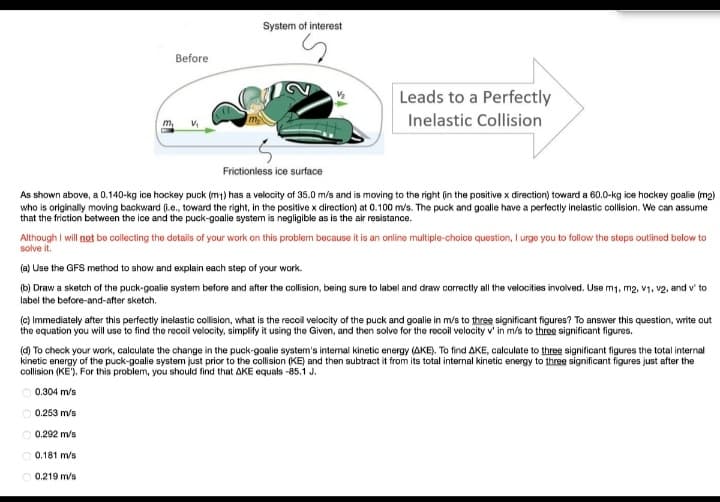label the before-and-after sketch. (c) Immediately after this perfectly inelastic collision, what is the recol velocity of the puck and goalie in m/s to three significant figures? To answer this question, write out the equation you will use to find the recoil velocity, simplify it using the Given, and then solve for the recoil velocity v' in m/s to three significant figures. (d) To check your work, calculate the change in the puck-goalie system's intemal kinetic energy (AKE). To find AKE, calculate to three significant figures the total internal kinetic energy of the puck-goalie system just prior to the collision (KE) and then subtract it from its total internal kinetic energy to three significant figures just after the collision (KE). For this problem, you should find that AKE equals -85.1 J.
label the before-and-after sketch. (c) Immediately after this perfectly inelastic collision, what is the recol velocity of the puck and goalie in m/s to three significant figures? To answer this question, write out the equation you will use to find the recoil velocity, simplify it using the Given, and then solve for the recoil velocity v' in m/s to three significant figures. (d) To check your work, calculate the change in the puck-goalie system's intemal kinetic energy (AKE). To find AKE, calculate to three significant figures the total internal kinetic energy of the puck-goalie system just prior to the collision (KE) and then subtract it from its total internal kinetic energy to three significant figures just after the collision (KE). For this problem, you should find that AKE equals -85.1 J.
Physics for Scientists and Engineers: Foundations and Connections
1st Edition
ISBN:9781133939146
Author:Katz, Debora M.
Publisher:Katz, Debora M.
Chapter10: Systems Of Particles And Conservation Of Momentum
Section: Chapter Questions
Problem 75PQ
Related questions
Question
100%

Transcribed Image Text:System of interest
Before
Leads to a Perfectly
Inelastic Collision
m
Frictionless ice surface
As shown above, a 0.140-kg ice hockey puck (m1) has a velocity of 35.0 m/s and is moving to the right (in the positive x direction) toward a 60.0-kg ice hockey goalie (m2)
who is originally moving backward (.e., toward the right, in the positive x direction) at 0.100 m/s. The puck and goalie have a perfectly inelastic collision. We can assume
that the friction between the ice and the puck-goalie system is negligible as is the air resistance.
Although I will not be collecting the details of your work on this problem because it is an online multiple-choice question, I urge you to follow the steps outlined below to
solve it.
(a) Use the GFS method to show and explain each step of your work.
(b) Draw a sketch of the puck-goalie system before and after the collision, being sure to label and draw correctly all the velocities involved. Use m1, m2, v1, v2, and v' to
label the before-and-after sketch.
(c) Immediately after this perfectly inelastic collision, what is the recoil velocity of the puck and goalie in m/s to three significant figures? To answer this question, write out
the equation you will use to find the reccil velocity, simplify it using the Given, and then solve for the recoil velocity v' in m/s to three significant figures.
(d) To check your work, calculate the change in the puck-goalie system's intemal kinetic energy (AKE). To find AKE, calculate to three significant figures the total internal
kinetic energy of the puck-goalie system just prior to the collision (KE) and then subtract it from its total internal kinetic energy to three significant figures just after the
collision (KE'). For this problem, you should find that AKE equals -85.1 J.
O 0.304 m/s
0.253 m/s
0.292 m/s
O 0.181 m/s
0.219 m/s
Expert Solution
This question has been solved!
Explore an expertly crafted, step-by-step solution for a thorough understanding of key concepts.
Step by step
Solved in 2 steps with 1 images

Knowledge Booster
Learn more about
Need a deep-dive on the concept behind this application? Look no further. Learn more about this topic, physics and related others by exploring similar questions and additional content below.Recommended textbooks for you

Physics for Scientists and Engineers: Foundations…
Physics
ISBN:
9781133939146
Author:
Katz, Debora M.
Publisher:
Cengage Learning

University Physics Volume 1
Physics
ISBN:
9781938168277
Author:
William Moebs, Samuel J. Ling, Jeff Sanny
Publisher:
OpenStax - Rice University

Glencoe Physics: Principles and Problems, Student…
Physics
ISBN:
9780078807213
Author:
Paul W. Zitzewitz
Publisher:
Glencoe/McGraw-Hill

Physics for Scientists and Engineers: Foundations…
Physics
ISBN:
9781133939146
Author:
Katz, Debora M.
Publisher:
Cengage Learning

University Physics Volume 1
Physics
ISBN:
9781938168277
Author:
William Moebs, Samuel J. Ling, Jeff Sanny
Publisher:
OpenStax - Rice University

Glencoe Physics: Principles and Problems, Student…
Physics
ISBN:
9780078807213
Author:
Paul W. Zitzewitz
Publisher:
Glencoe/McGraw-Hill

College Physics
Physics
ISBN:
9781305952300
Author:
Raymond A. Serway, Chris Vuille
Publisher:
Cengage Learning

Principles of Physics: A Calculus-Based Text
Physics
ISBN:
9781133104261
Author:
Raymond A. Serway, John W. Jewett
Publisher:
Cengage Learning
